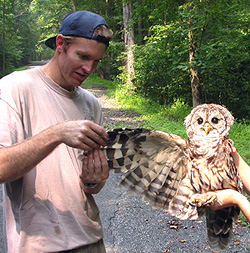Two UC Santa Cruz researchers, Winifred F. Frick and A. Marm Kilpatrick, have won a $2 million National Science Foundation (NSF) grant to study the spread of a fungus that is decimating bat populations in the northeastern United States.
The fungus causes "white-nose syndrome" that is blamed for the deaths of more than 70 percent of the little brown bat population in the northeast, said Frick, an NSF bioinformatics post-doctoral fellow in UCSC's Environmental Studies department. Earlier work by Frick and colleague Tom Kunz at Boston University predicts the bat populations may become extinct over the next 15 years if the fungus's spread cannot be halted.
"We want to understand the transmission and spread of the pathogen that causes white-nose syndrome," Frick said. The five-year grant is from the NSF's ecology of infectious disease program.
Frick and Kilpatrick, a UCSC assistant professor of ecology & evolutionary biology, will work with Kunz and colleagues from the University of Tennessee and Northern Arizona University. The team will investigate the origin, life cycle, and both seasonal and spatial transmission of the mysterious disease.
Discovered near Albany, N.Y. in 2006, the fungus disrupts bats' hibernation, causing them to awake early, behave oddly, and lose critical fat reserves, resulting in death. It already affects nine bat species across the northeast.
"Kilpatrick will use the data collected from the field studies to build a model of transmission dynamics that can be used to predict the impact of the disease on bats, and to highlight potential management opportunities.
In particular, Kilpatrick said, they will examine how the "sociality" of different bat populations influences how the fungus spreads. "The big scientific question is to try to understand how differences in sociality -- group size and mixing patterns – increase or decrease transmission within a population," Kilpatrick said.
The research will provide critical information on the factors driving the spread of the fungus between individuals, among hibernation locations such as caves within a region, and across North America. The information can be used to predict the impact of the fungus on bat populations and is likely to identify species and populations of greatest concern.
Kilpatrick is a disease ecologist and expert on West Nile virus and chytrid fungus in amphibians who joined the UCSC faculty in 2008.
Frick, who currently is in Texas studying bat populations using weather radar, received her B.A. in environmental studies at UCSC (Porter '98). She completed her Ph.D. at Oregon State University in 2007 and currently holds a joint appointment at UCSC and Boston University.
Researchers win $2 million grant to study spread of bat-killing fungus
National Science Foundation-funded study will seek to understand white-nose syndrome and how it is transmitted




